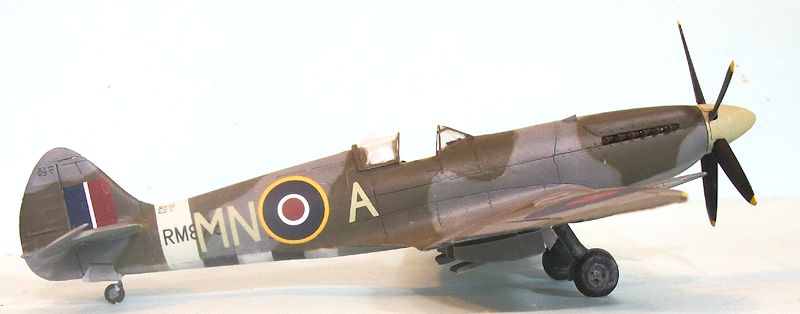
Eduard/Airfix 1/48 Spitfire XIVc
| KIT #: | |
| PRICE: | $ |
| DECALS: | |
| REVIEWER: | Tom Cleaver |
| NOTES: | New tool kitKitbash using Airfix PR.XIX and Eduard IXc (early). Xtradecal 48127 |

| HISTORY |
Development
of the Spitfire to use the more powerful Rolls-Royce Griffon engine began in
late 1940, with what was first known as the Spitfire IV, which was to use the
Griffon II and was known as the Type 337.
The airframe involved extensive modification to absorb
the additional power; at one time it flew with a mockup of no less than three
20mm cannon in each wing.
Before the prototype DP845 flew, it was designated the
Spitfire XX to distinguish it from the P.R. Mk. IV.
Plans that all XX-series Spitfires would be
Griffon-powered were changed when the interim Mk. XII and Mk. XIV types were
introduced.
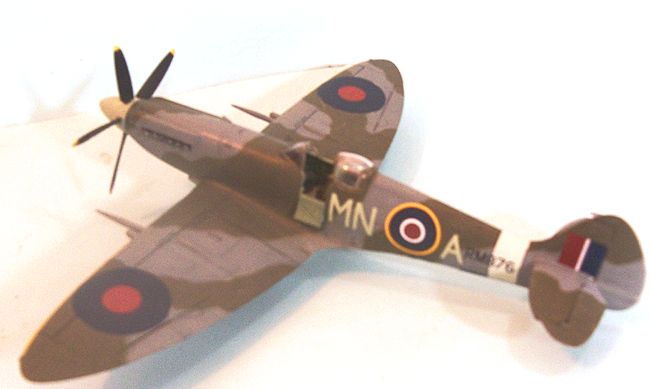 The Mk. XII
was an emergency creation to deal with the low-level "tip-and run" raids by
Fw-190s and involved mating the Griffon II engine to a Mk. Vc airframe. The more
detailed development utilized DP851, which was used to develop the Griffon 61
series.
DP851 was further developed into the Spitfire XXI.
In order to gain further experience with the Griffon-61,
six Mk. VIII airframes, JF316 to JF321 were modified to take the Griffon engine.
Experience with these airplanes showed it would be
possible to create a Griffon-powered high-altitude air superiority fighter in a
faster timeframe than envisioned with the Spitfire XXI by mating the Griffon to
the Mk. VIII airframe the way the Merlin-61 had been mated to the Spitfire Vc.
Thus, third major development of the Spitfire saw the
"interim" type produced in larger numbers and used more widely than the version
developed specifically to use the engine change.
The Mk. XII
was an emergency creation to deal with the low-level "tip-and run" raids by
Fw-190s and involved mating the Griffon II engine to a Mk. Vc airframe. The more
detailed development utilized DP851, which was used to develop the Griffon 61
series.
DP851 was further developed into the Spitfire XXI.
In order to gain further experience with the Griffon-61,
six Mk. VIII airframes, JF316 to JF321 were modified to take the Griffon engine.
Experience with these airplanes showed it would be
possible to create a Griffon-powered high-altitude air superiority fighter in a
faster timeframe than envisioned with the Spitfire XXI by mating the Griffon to
the Mk. VIII airframe the way the Merlin-61 had been mated to the Spitfire Vc.
Thus, third major development of the Spitfire saw the
"interim" type produced in larger numbers and used more widely than the version
developed specifically to use the engine change.
Like the Spitfire V and Spitfire IXC, the Spitfire
XIV was an "interim" type pending production of the "definitive" Spitfire XVIII,
which utilized a "beefed-up" Mk. VIII airframe with larger radiators and first
appeared with the "C" wing.
The first squadron to equip with the new type was 610, a
former RAuxAF squadron which had been among to equip with the original Spitfire.
The Mk. XIVs arrived in January 1945.
By March, 350 (Belgian) Squadron was also equipping with
the type, as was 130 Squadron.
These three would form the Newchurch Wing, which became
operational in May 1944, just before the invasion.
The thre squadrons were in a long work-up period to get
used to this very different Spitfire, in which the prop rotated the opposite of
all previous Spitfires and required judicious application of throttle and rudder
on takeoff to avoid a torque roll on takeoff, not to mention the new type was
far more nose-heavy than the Spitfires the pilots were used to.
A few fighter sweeps happened before D-Day.
The Spitfire XIV was intended to provide high
altitude air superiority, to complement the medium-altitude Tempest V.
Both these types delayed their entry into air combat
over the Continent due to the deployment by the Germans of the Fi-103, the first
of which exploded in England two days after the invasion.
It was quickly ascertained that the best defense against
these robots were standing patrols by the fastest Allied fighters.
Over the course of the anti-diver campaign, which only
ended when the launch
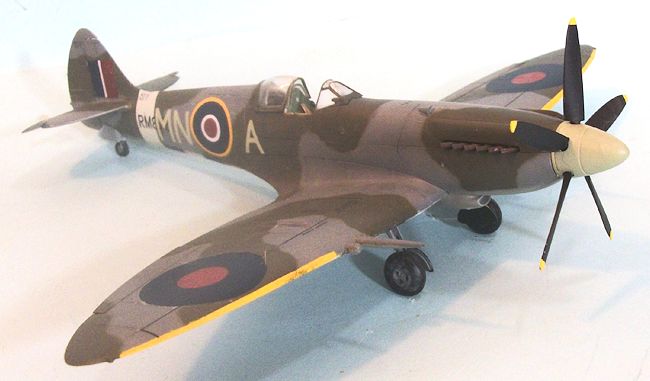 sites in
Belgium were overrun by the Allied armies in September 1944, the Spitfire XIV
emerged as the most successful of all Spitfire types in destroying the "buzz
bombs."
sites in
Belgium were overrun by the Allied armies in September 1944, the Spitfire XIV
emerged as the most successful of all Spitfire types in destroying the "buzz
bombs."
The Mk. XIV arrived on the Continent at about the
same time the Jagdflieger were
re-equipping with the Langnasen Dora,
the Fw-190D-9.
The Spitfire XIV had superior performance above 25,000 feet, but
most fights over the Western Front happened at lower altitudes.
Thus, as had been the case with the Spitfire since the
first introduction of the Fw-190, the new version just maintained superiority
over the latest 190, with pilot quality being the deciding element.
By V-E Day, 20 RAF squadrons were equipped with the Spitfire XIV in Europe, and the type had arrived in the Southeast Asia Theater. While Spitfire squadrons quickly re-equipped with the new airplane, the Pacific War came to a fast end before they could enter combat.
| THE KIT |
There is no really accurate Spitfire XIV kit in 1/48
(the only really accurate kit being the PCM 1/32 Spitfire XIV).
Over the years, Aeroclub released limited-run Griffon
Spitfire fuselages to use with the Hasegawa Spitfire IX kit, and I previously
did a kitbash using the Planet Models resin Spitfire 21 fuselage with the
Hasegawa wings and horizontal stabs.
This model came about when after I had built an
Airfix Spitfire P.R. XIX and seen how good that kit's fuselage was.
I had also purchased a weekend edition Eduard Spitfire
IXc (Early) which had two sets of
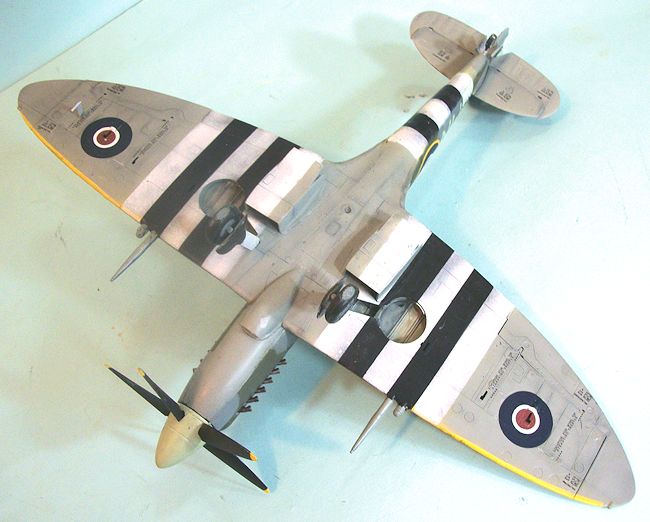 wings: one
with the large "universal" cannon cover and one with the narrow-chord cannon
cover.
I had the later wing left over from that project.
I sanded the wing lightly after assembling it and the
very petite rivet detail promptly disappeared, leaving me with a wing that would
possibly work with an Airfix (unrivetted) kit.
wings: one
with the large "universal" cannon cover and one with the narrow-chord cannon
cover.
I had the later wing left over from that project.
I sanded the wing lightly after assembling it and the
very petite rivet detail promptly disappeared, leaving me with a wing that would
possibly work with an Airfix (unrivetted) kit.
I bought another Spitfire XIX and taped the fuselage
halves together and tried mating that with the Eduard wing.
The rear fuselage/wing join on the Eduard kit was a bit
longer than that of the Airfix fuselage, but that was easily solved with a razor
saw cutting out the fuselage area to fit.
The upper wing/fuselage joint had some gaps, but that
could be easily solved with the application of some putty and judicious sanding.
I would also have to cut off and fill in the Aero-Vee
air intake so I could use the Airfix air intake.
The big thing was that the Spitfire XIX did not have
the same windshield as the Spitfire XIV.
I solved that problem by taking an old ICM kit and
cutting out the gas tank and forward cockpit area above the fuselage centerline,
and mating that with the fuselage.
I was able to use the Eduard closed canopy, which I cut
open to get the windshield, then used the Airfix canopy and rear glass, which
had to be puttied in so it could be painted to have the elevated lower line for
the glass.
All the cutting, puttying and fiddling was easy once I had assembled the cockpit and installed it. I used the extra Eduard side flap so I could open the cockpit. Once I had the airframe assembled, attaching the larger Airfix radiator housings proved not to be a problem at all.
| COLORS & MARKINGS |
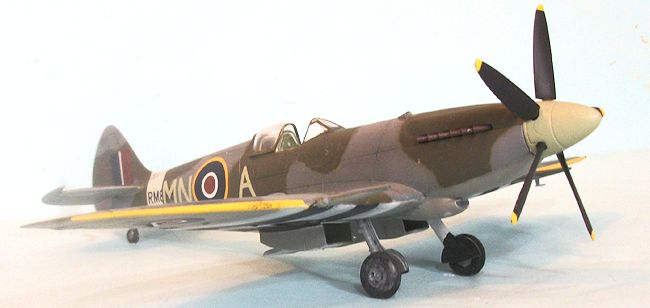 I decided to
do a 350 Squadron F.XIVc from the Xtradecal sheet 48127 "Spitfire XIV - XVIII",
so I first painted the white area of the D-Day stripes on the lower surfaces,
masked those off, painted the black stripes and masked those off, painted the
yellow wing leading edge and masked that off, painted the Sky fuselage band and
masked that off, then pre-shaded the rest of the model and gave it an "A-scheme"
pattern frehanded with Tamiya RAF Dark Green, Ocean Grey and Sea Grey Medium.
I then gave the model a coat of Future.
I decided to
do a 350 Squadron F.XIVc from the Xtradecal sheet 48127 "Spitfire XIV - XVIII",
so I first painted the white area of the D-Day stripes on the lower surfaces,
masked those off, painted the black stripes and masked those off, painted the
yellow wing leading edge and masked that off, painted the Sky fuselage band and
masked that off, then pre-shaded the rest of the model and gave it an "A-scheme"
pattern frehanded with Tamiya RAF Dark Green, Ocean Grey and Sea Grey Medium.
I then gave the model a coat of Future.
The decals went on without problem.
The two Xtradecal sheets for Griffon Spitfires are very
nice.
I attached the prop and landing gear and unmasked the
canopy, posing it in the open position.
| CONCLUSIONS |

Kits provided courtesy of my billfold. Decals courtesy of Hannant's.
If you would like your product reviewed fairly and fairly quickly, please contact the editor or see other details in the Note to Contributors.